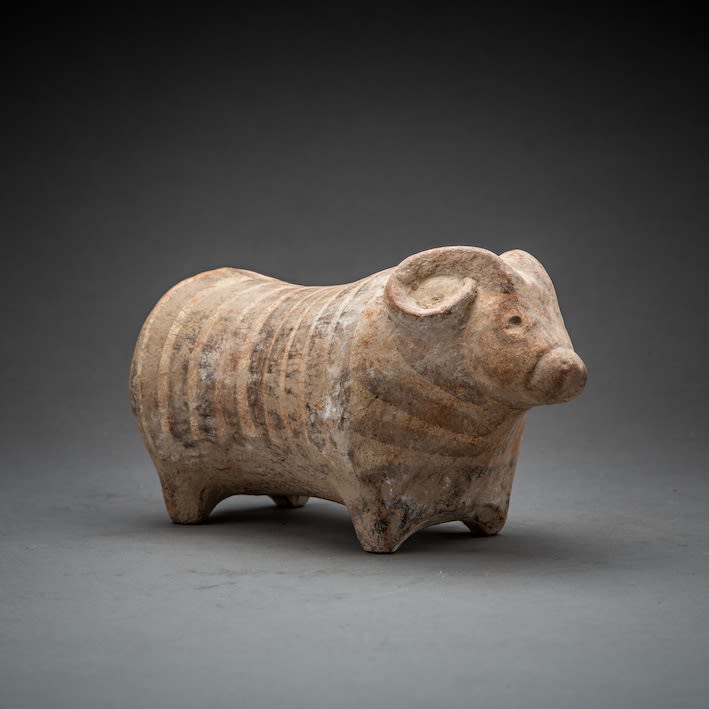Indus Valley Terracotta Ram, 2300 BCE - 1900 BCE
Terracotta
MS.1979
Further images
The Indus Valley civilization was rediscovered in 1920-21 when engraved seals were unearthed in the Punjab province of Pakistan at a site called Harappa, a name which is often used...
The Indus Valley civilization was rediscovered in 1920-21 when engraved seals were unearthed in the Punjab province of Pakistan at a site called Harappa, a name which is often used to describe the civilization as a whole. Subsequent excavations at Harappa revealed the size and complexity of this ancient city. Other sites were unearthed as well along the banks of the Indus River, including the equally large city of Mohenjodaro. Through archaeological and historical research, we can now say for certain that a highly developed urban civilization flourished in the Indian subcontinent over five thousand years ago. Though the Indus Valley script remains undeciphered, the numerous seals, statuary, and pottery discovered during excavations, not to mention the urban ruins, have enabled scholars to construct a reasonably plausible account of the Indus Valley civilization.
Some kind of centralized state, and certainly fairly extensive town planning, is suggested by the layout of the great cities of Harappa and Mohenjodaro. The same kind of burnt brick appears to have been used in the construction of buildings in cities that were several hundred miles apart. The weights and measures also show a very considerable regularity, suggesting that these disparate cities spread out across a vast desert shared a common culture. The Indus Valley people domesticated animals, and harvested various crops, such as cotton, sesame, peas, barley, and cotton. Indus Valley seals have been excavated in far away cities such as Sumer, suggesting that a wealthy merchant class existed, engaged in extensive trading throughout the subcontinent and the Near East.
Other than the archaeological ruins of Harappa and Mohenjodaro, the figurines provide the most detailed clues about the character of the Indus Valley people. Terracotta figurines such as these ones have been unearthed also at Mohenjo-daro and Harappa, suggesting a commonality of style and purpose throughout the Indus Valley during the mature Harappan period (ca. 2600-2450 BCE). Like many figurines datable to this period, the front and back legs are joined together. In one excavated example from Chanu-daro a hole was poked in the belly, indicating that it would have been attached to a stick for use as a puppet or a small standard of the kind carried in the processions depicted on some seals. In others, the hole was indeed placed on the back of the animal, thus suggesting an alternative function, perhaps linked to music.
For a comparable example see: J.Aruz ed, Art of the Ancient Cities, 2003: no.276, p.390. J.Kenoyer, Ancient Cities of the Indus Valley Civilization, 1998.
Some kind of centralized state, and certainly fairly extensive town planning, is suggested by the layout of the great cities of Harappa and Mohenjodaro. The same kind of burnt brick appears to have been used in the construction of buildings in cities that were several hundred miles apart. The weights and measures also show a very considerable regularity, suggesting that these disparate cities spread out across a vast desert shared a common culture. The Indus Valley people domesticated animals, and harvested various crops, such as cotton, sesame, peas, barley, and cotton. Indus Valley seals have been excavated in far away cities such as Sumer, suggesting that a wealthy merchant class existed, engaged in extensive trading throughout the subcontinent and the Near East.
Other than the archaeological ruins of Harappa and Mohenjodaro, the figurines provide the most detailed clues about the character of the Indus Valley people. Terracotta figurines such as these ones have been unearthed also at Mohenjo-daro and Harappa, suggesting a commonality of style and purpose throughout the Indus Valley during the mature Harappan period (ca. 2600-2450 BCE). Like many figurines datable to this period, the front and back legs are joined together. In one excavated example from Chanu-daro a hole was poked in the belly, indicating that it would have been attached to a stick for use as a puppet or a small standard of the kind carried in the processions depicted on some seals. In others, the hole was indeed placed on the back of the animal, thus suggesting an alternative function, perhaps linked to music.
For a comparable example see: J.Aruz ed, Art of the Ancient Cities, 2003: no.276, p.390. J.Kenoyer, Ancient Cities of the Indus Valley Civilization, 1998.





